Comparative Attention for Congruent and Incongruent Distraction
VerifiedAdded on 2023/06/10
|16
|3050
|139
AI Summary
This study examines the impact of unattended objects on human attention and behavior. The research involved 149 respondents from first year psychology of the University of Roehampton. Response time for the visual experiment was taken as the dependent variable, where it was measured for three independent factors. The finding revealed the adverse effect of incongruent distracting and divulged the reason for late attention.
Contribute Materials
Your contribution can guide someone’s learning journey. Share your
documents today.

1
Comparative Attention for Congruent and Incongruent Distraction
Abstract
Visual choice is flawed; at whatever point an unpredictable exhibit of items is handled,
portrayals of numerous articles are probably going to be dynamic at the same time. Proof of
these connections originates from measures of distraction obstruction and from the weakening of
distraction impacts by different non targets. In the current study, the impact of unattended objects
on human attention and behavior was observed. The research work involved 149 respondents
from first year psychology of the University of Roehampton. Response time for the visual
experiment was taken as the dependent variable, where it was measured for three independent
factors. Visual response time was found to be significantly greater in incongruent disturbances
compared to congruent distractions. The finding revealed the adverse effect of incongruent
distracting and divulged the reason for late attention.
Total word count: 1795
Comparative Attention for Congruent and Incongruent Distraction
Abstract
Visual choice is flawed; at whatever point an unpredictable exhibit of items is handled,
portrayals of numerous articles are probably going to be dynamic at the same time. Proof of
these connections originates from measures of distraction obstruction and from the weakening of
distraction impacts by different non targets. In the current study, the impact of unattended objects
on human attention and behavior was observed. The research work involved 149 respondents
from first year psychology of the University of Roehampton. Response time for the visual
experiment was taken as the dependent variable, where it was measured for three independent
factors. Visual response time was found to be significantly greater in incongruent disturbances
compared to congruent distractions. The finding revealed the adverse effect of incongruent
distracting and divulged the reason for late attention.
Total word count: 1795
Secure Best Marks with AI Grader
Need help grading? Try our AI Grader for instant feedback on your assignments.
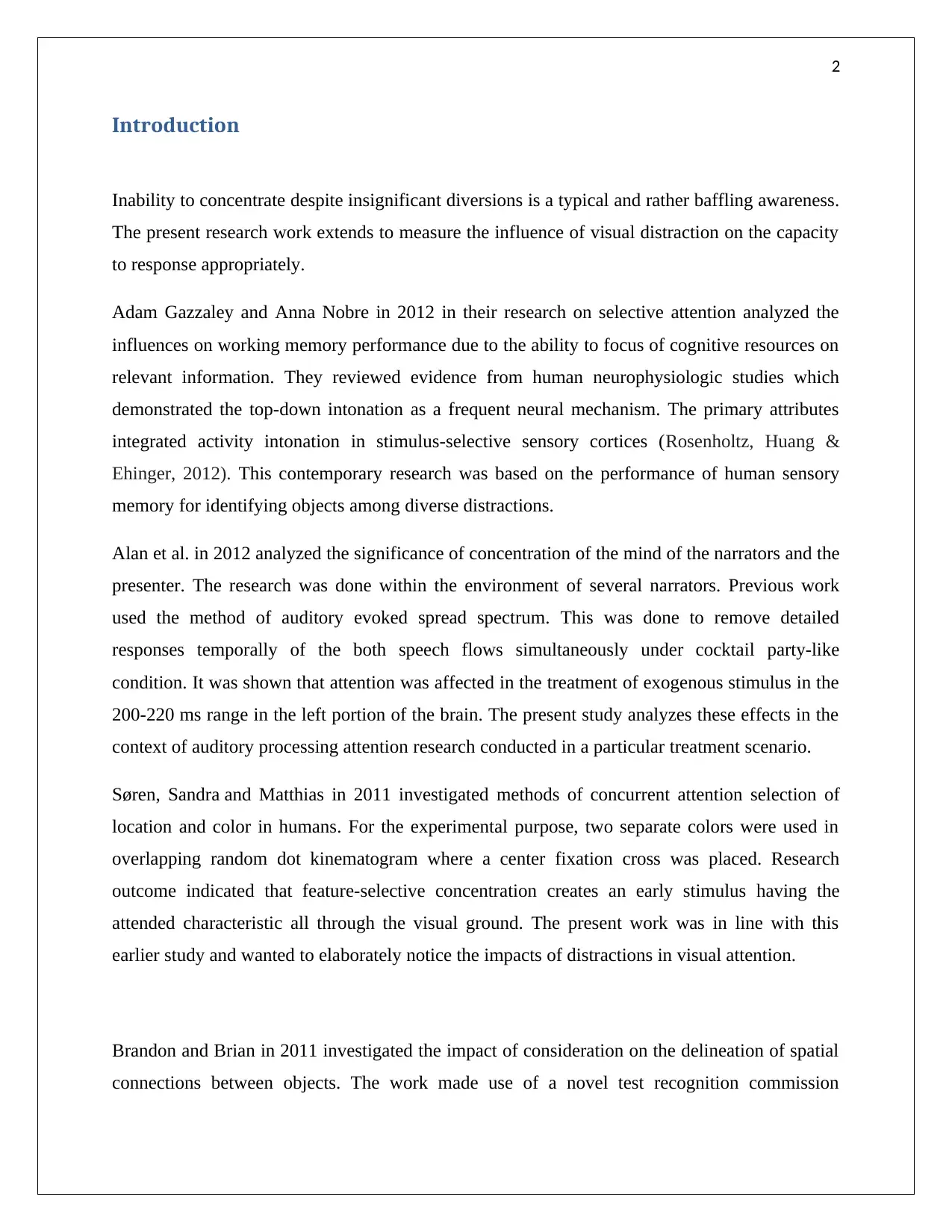
2
Introduction
Inability to concentrate despite insignificant diversions is a typical and rather baffling awareness.
The present research work extends to measure the influence of visual distraction on the capacity
to response appropriately.
Adam Gazzaley and Anna Nobre in 2012 in their research on selective attention analyzed the
influences on working memory performance due to the ability to focus of cognitive resources on
relevant information. They reviewed evidence from human neurophysiologic studies which
demonstrated the top-down intonation as a frequent neural mechanism. The primary attributes
integrated activity intonation in stimulus-selective sensory cortices (Rosenholtz, Huang &
Ehinger, 2012). This contemporary research was based on the performance of human sensory
memory for identifying objects among diverse distractions.
Alan et al. in 2012 analyzed the significance of concentration of the mind of the narrators and the
presenter. The research was done within the environment of several narrators. Previous work
used the method of auditory evoked spread spectrum. This was done to remove detailed
responses temporally of the both speech flows simultaneously under cocktail party-like
condition. It was shown that attention was affected in the treatment of exogenous stimulus in the
200-220 ms range in the left portion of the brain. The present study analyzes these effects in the
context of auditory processing attention research conducted in a particular treatment scenario.
Søren, Sandra and Matthias in 2011 investigated methods of concurrent attention selection of
location and color in humans. For the experimental purpose, two separate colors were used in
overlapping random dot kinematogram where a center fixation cross was placed. Research
outcome indicated that feature-selective concentration creates an early stimulus having the
attended characteristic all through the visual ground. The present work was in line with this
earlier study and wanted to elaborately notice the impacts of distractions in visual attention.
Brandon and Brian in 2011 investigated the impact of consideration on the delineation of spatial
connections between objects. The work made use of a novel test recognition commission
Introduction
Inability to concentrate despite insignificant diversions is a typical and rather baffling awareness.
The present research work extends to measure the influence of visual distraction on the capacity
to response appropriately.
Adam Gazzaley and Anna Nobre in 2012 in their research on selective attention analyzed the
influences on working memory performance due to the ability to focus of cognitive resources on
relevant information. They reviewed evidence from human neurophysiologic studies which
demonstrated the top-down intonation as a frequent neural mechanism. The primary attributes
integrated activity intonation in stimulus-selective sensory cortices (Rosenholtz, Huang &
Ehinger, 2012). This contemporary research was based on the performance of human sensory
memory for identifying objects among diverse distractions.
Alan et al. in 2012 analyzed the significance of concentration of the mind of the narrators and the
presenter. The research was done within the environment of several narrators. Previous work
used the method of auditory evoked spread spectrum. This was done to remove detailed
responses temporally of the both speech flows simultaneously under cocktail party-like
condition. It was shown that attention was affected in the treatment of exogenous stimulus in the
200-220 ms range in the left portion of the brain. The present study analyzes these effects in the
context of auditory processing attention research conducted in a particular treatment scenario.
Søren, Sandra and Matthias in 2011 investigated methods of concurrent attention selection of
location and color in humans. For the experimental purpose, two separate colors were used in
overlapping random dot kinematogram where a center fixation cross was placed. Research
outcome indicated that feature-selective concentration creates an early stimulus having the
attended characteristic all through the visual ground. The present work was in line with this
earlier study and wanted to elaborately notice the impacts of distractions in visual attention.
Brandon and Brian in 2011 investigated the impact of consideration on the delineation of spatial
connections between objects. The work made use of a novel test recognition commission
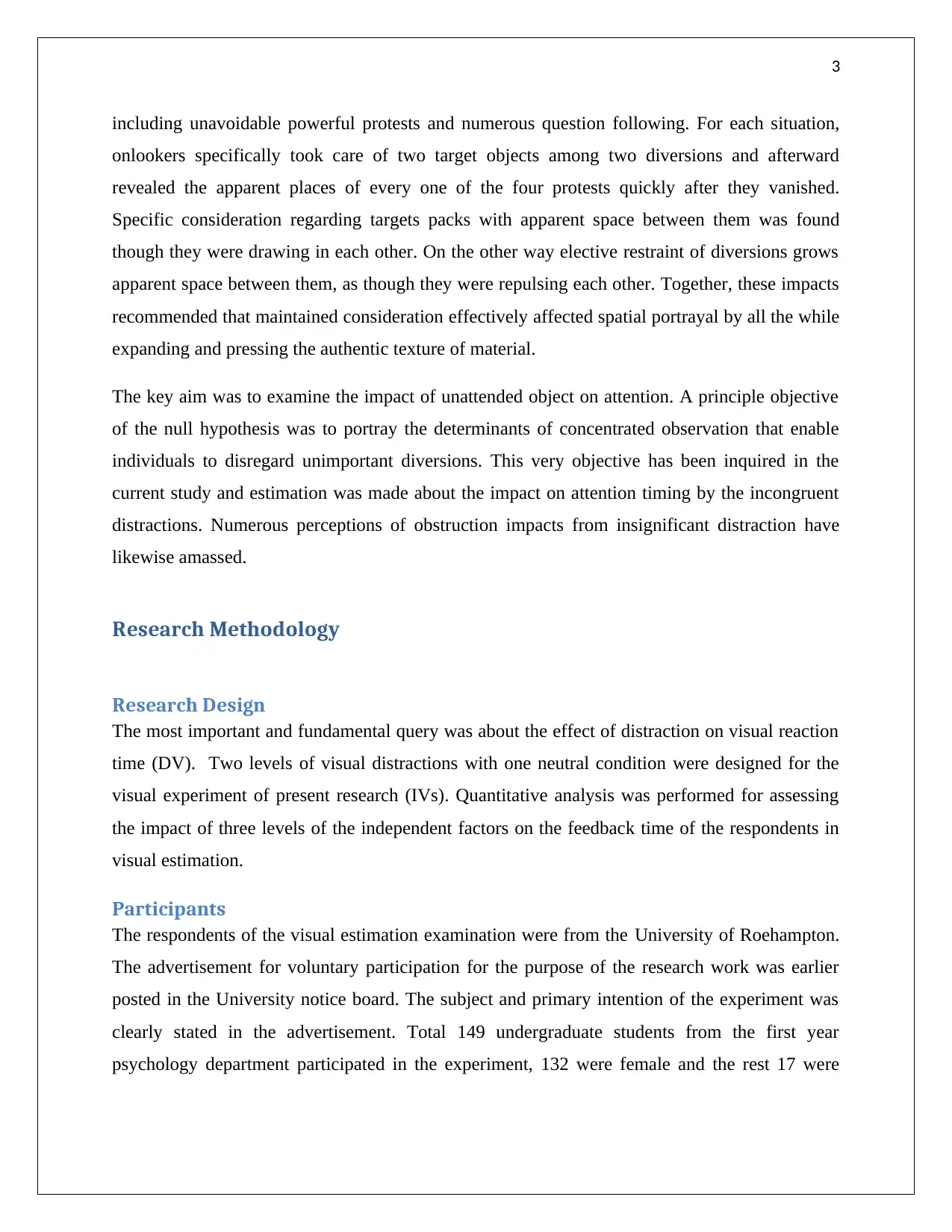
3
including unavoidable powerful protests and numerous question following. For each situation,
onlookers specifically took care of two target objects among two diversions and afterward
revealed the apparent places of every one of the four protests quickly after they vanished.
Specific consideration regarding targets packs with apparent space between them was found
though they were drawing in each other. On the other way elective restraint of diversions grows
apparent space between them, as though they were repulsing each other. Together, these impacts
recommended that maintained consideration effectively affected spatial portrayal by all the while
expanding and pressing the authentic texture of material.
The key aim was to examine the impact of unattended object on attention. A principle objective
of the null hypothesis was to portray the determinants of concentrated observation that enable
individuals to disregard unimportant diversions. This very objective has been inquired in the
current study and estimation was made about the impact on attention timing by the incongruent
distractions. Numerous perceptions of obstruction impacts from insignificant distraction have
likewise amassed.
Research Methodology
Research Design
The most important and fundamental query was about the effect of distraction on visual reaction
time (DV). Two levels of visual distractions with one neutral condition were designed for the
visual experiment of present research (IVs). Quantitative analysis was performed for assessing
the impact of three levels of the independent factors on the feedback time of the respondents in
visual estimation.
Participants
The respondents of the visual estimation examination were from the University of Roehampton.
The advertisement for voluntary participation for the purpose of the research work was earlier
posted in the University notice board. The subject and primary intention of the experiment was
clearly stated in the advertisement. Total 149 undergraduate students from the first year
psychology department participated in the experiment, 132 were female and the rest 17 were
including unavoidable powerful protests and numerous question following. For each situation,
onlookers specifically took care of two target objects among two diversions and afterward
revealed the apparent places of every one of the four protests quickly after they vanished.
Specific consideration regarding targets packs with apparent space between them was found
though they were drawing in each other. On the other way elective restraint of diversions grows
apparent space between them, as though they were repulsing each other. Together, these impacts
recommended that maintained consideration effectively affected spatial portrayal by all the while
expanding and pressing the authentic texture of material.
The key aim was to examine the impact of unattended object on attention. A principle objective
of the null hypothesis was to portray the determinants of concentrated observation that enable
individuals to disregard unimportant diversions. This very objective has been inquired in the
current study and estimation was made about the impact on attention timing by the incongruent
distractions. Numerous perceptions of obstruction impacts from insignificant distraction have
likewise amassed.
Research Methodology
Research Design
The most important and fundamental query was about the effect of distraction on visual reaction
time (DV). Two levels of visual distractions with one neutral condition were designed for the
visual experiment of present research (IVs). Quantitative analysis was performed for assessing
the impact of three levels of the independent factors on the feedback time of the respondents in
visual estimation.
Participants
The respondents of the visual estimation examination were from the University of Roehampton.
The advertisement for voluntary participation for the purpose of the research work was earlier
posted in the University notice board. The subject and primary intention of the experiment was
clearly stated in the advertisement. Total 149 undergraduate students from the first year
psychology department participated in the experiment, 132 were female and the rest 17 were
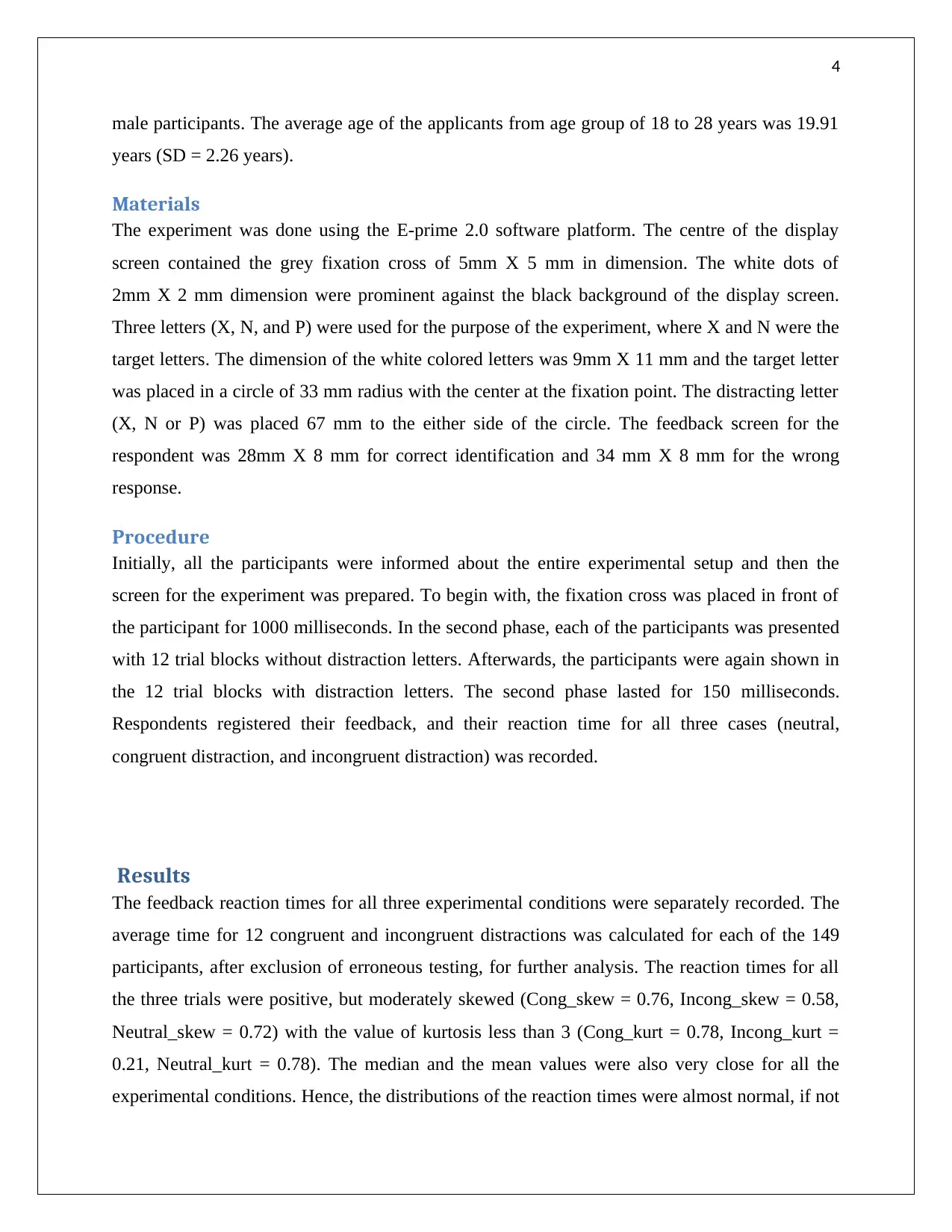
4
male participants. The average age of the applicants from age group of 18 to 28 years was 19.91
years (SD = 2.26 years).
Materials
The experiment was done using the E-prime 2.0 software platform. The centre of the display
screen contained the grey fixation cross of 5mm X 5 mm in dimension. The white dots of
2mm X 2 mm dimension were prominent against the black background of the display screen.
Three letters (X, N, and P) were used for the purpose of the experiment, where X and N were the
target letters. The dimension of the white colored letters was 9mm X 11 mm and the target letter
was placed in a circle of 33 mm radius with the center at the fixation point. The distracting letter
(X, N or P) was placed 67 mm to the either side of the circle. The feedback screen for the
respondent was 28mm X 8 mm for correct identification and 34 mm X 8 mm for the wrong
response.
Procedure
Initially, all the participants were informed about the entire experimental setup and then the
screen for the experiment was prepared. To begin with, the fixation cross was placed in front of
the participant for 1000 milliseconds. In the second phase, each of the participants was presented
with 12 trial blocks without distraction letters. Afterwards, the participants were again shown in
the 12 trial blocks with distraction letters. The second phase lasted for 150 milliseconds.
Respondents registered their feedback, and their reaction time for all three cases (neutral,
congruent distraction, and incongruent distraction) was recorded.
Results
The feedback reaction times for all three experimental conditions were separately recorded. The
average time for 12 congruent and incongruent distractions was calculated for each of the 149
participants, after exclusion of erroneous testing, for further analysis. The reaction times for all
the three trials were positive, but moderately skewed (Cong_skew = 0.76, Incong_skew = 0.58,
Neutral_skew = 0.72) with the value of kurtosis less than 3 (Cong_kurt = 0.78, Incong_kurt =
0.21, Neutral_kurt = 0.78). The median and the mean values were also very close for all the
experimental conditions. Hence, the distributions of the reaction times were almost normal, if not
male participants. The average age of the applicants from age group of 18 to 28 years was 19.91
years (SD = 2.26 years).
Materials
The experiment was done using the E-prime 2.0 software platform. The centre of the display
screen contained the grey fixation cross of 5mm X 5 mm in dimension. The white dots of
2mm X 2 mm dimension were prominent against the black background of the display screen.
Three letters (X, N, and P) were used for the purpose of the experiment, where X and N were the
target letters. The dimension of the white colored letters was 9mm X 11 mm and the target letter
was placed in a circle of 33 mm radius with the center at the fixation point. The distracting letter
(X, N or P) was placed 67 mm to the either side of the circle. The feedback screen for the
respondent was 28mm X 8 mm for correct identification and 34 mm X 8 mm for the wrong
response.
Procedure
Initially, all the participants were informed about the entire experimental setup and then the
screen for the experiment was prepared. To begin with, the fixation cross was placed in front of
the participant for 1000 milliseconds. In the second phase, each of the participants was presented
with 12 trial blocks without distraction letters. Afterwards, the participants were again shown in
the 12 trial blocks with distraction letters. The second phase lasted for 150 milliseconds.
Respondents registered their feedback, and their reaction time for all three cases (neutral,
congruent distraction, and incongruent distraction) was recorded.
Results
The feedback reaction times for all three experimental conditions were separately recorded. The
average time for 12 congruent and incongruent distractions was calculated for each of the 149
participants, after exclusion of erroneous testing, for further analysis. The reaction times for all
the three trials were positive, but moderately skewed (Cong_skew = 0.76, Incong_skew = 0.58,
Neutral_skew = 0.72) with the value of kurtosis less than 3 (Cong_kurt = 0.78, Incong_kurt =
0.21, Neutral_kurt = 0.78). The median and the mean values were also very close for all the
experimental conditions. Hence, the distributions of the reaction times were almost normal, if not
Secure Best Marks with AI Grader
Need help grading? Try our AI Grader for instant feedback on your assignments.
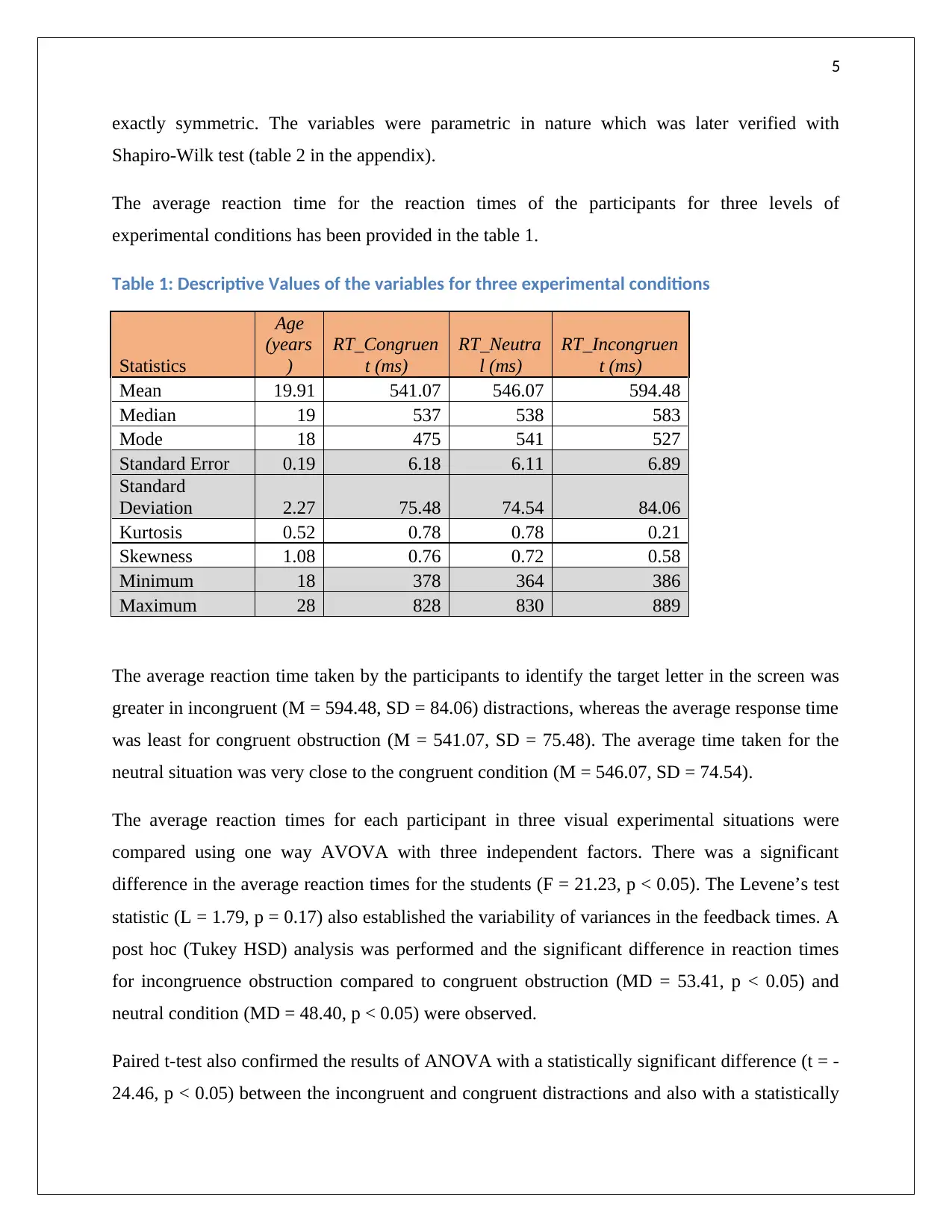
5
exactly symmetric. The variables were parametric in nature which was later verified with
Shapiro-Wilk test (table 2 in the appendix).
The average reaction time for the reaction times of the participants for three levels of
experimental conditions has been provided in the table 1.
Table 1: Descriptive Values of the variables for three experimental conditions
Statistics
Age
(years
)
RT_Congruen
t (ms)
RT_Neutra
l (ms)
RT_Incongruen
t (ms)
Mean 19.91 541.07 546.07 594.48
Median 19 537 538 583
Mode 18 475 541 527
Standard Error 0.19 6.18 6.11 6.89
Standard
Deviation 2.27 75.48 74.54 84.06
Kurtosis 0.52 0.78 0.78 0.21
Skewness 1.08 0.76 0.72 0.58
Minimum 18 378 364 386
Maximum 28 828 830 889
The average reaction time taken by the participants to identify the target letter in the screen was
greater in incongruent (M = 594.48, SD = 84.06) distractions, whereas the average response time
was least for congruent obstruction (M = 541.07, SD = 75.48). The average time taken for the
neutral situation was very close to the congruent condition (M = 546.07, SD = 74.54).
The average reaction times for each participant in three visual experimental situations were
compared using one way AVOVA with three independent factors. There was a significant
difference in the average reaction times for the students (F = 21.23, p < 0.05). The Levene’s test
statistic (L = 1.79, p = 0.17) also established the variability of variances in the feedback times. A
post hoc (Tukey HSD) analysis was performed and the significant difference in reaction times
for incongruence obstruction compared to congruent obstruction (MD = 53.41, p < 0.05) and
neutral condition (MD = 48.40, p < 0.05) were observed.
Paired t-test also confirmed the results of ANOVA with a statistically significant difference (t = -
24.46, p < 0.05) between the incongruent and congruent distractions and also with a statistically
exactly symmetric. The variables were parametric in nature which was later verified with
Shapiro-Wilk test (table 2 in the appendix).
The average reaction time for the reaction times of the participants for three levels of
experimental conditions has been provided in the table 1.
Table 1: Descriptive Values of the variables for three experimental conditions
Statistics
Age
(years
)
RT_Congruen
t (ms)
RT_Neutra
l (ms)
RT_Incongruen
t (ms)
Mean 19.91 541.07 546.07 594.48
Median 19 537 538 583
Mode 18 475 541 527
Standard Error 0.19 6.18 6.11 6.89
Standard
Deviation 2.27 75.48 74.54 84.06
Kurtosis 0.52 0.78 0.78 0.21
Skewness 1.08 0.76 0.72 0.58
Minimum 18 378 364 386
Maximum 28 828 830 889
The average reaction time taken by the participants to identify the target letter in the screen was
greater in incongruent (M = 594.48, SD = 84.06) distractions, whereas the average response time
was least for congruent obstruction (M = 541.07, SD = 75.48). The average time taken for the
neutral situation was very close to the congruent condition (M = 546.07, SD = 74.54).
The average reaction times for each participant in three visual experimental situations were
compared using one way AVOVA with three independent factors. There was a significant
difference in the average reaction times for the students (F = 21.23, p < 0.05). The Levene’s test
statistic (L = 1.79, p = 0.17) also established the variability of variances in the feedback times. A
post hoc (Tukey HSD) analysis was performed and the significant difference in reaction times
for incongruence obstruction compared to congruent obstruction (MD = 53.41, p < 0.05) and
neutral condition (MD = 48.40, p < 0.05) were observed.
Paired t-test also confirmed the results of ANOVA with a statistically significant difference (t = -
24.46, p < 0.05) between the incongruent and congruent distractions and also with a statistically
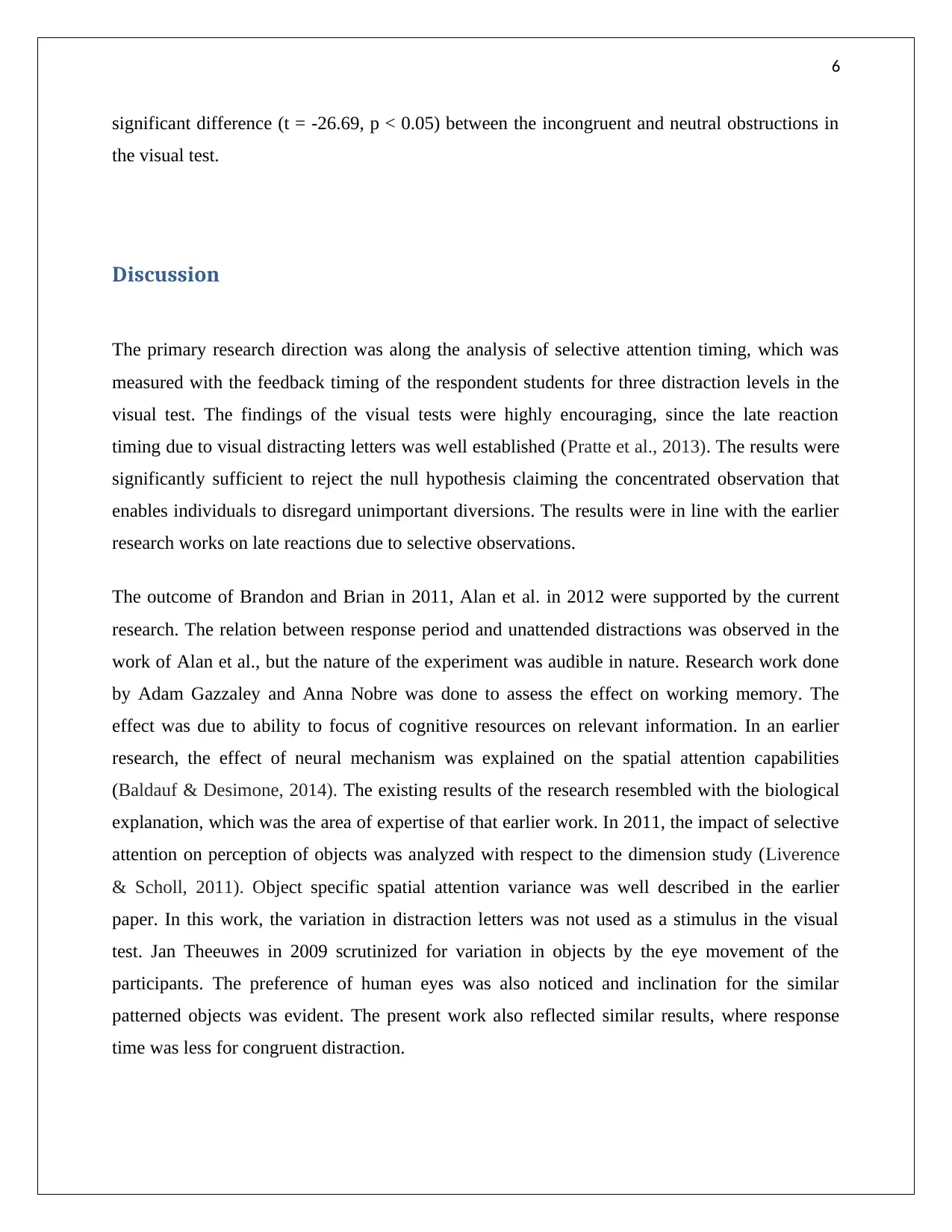
6
significant difference (t = -26.69, p < 0.05) between the incongruent and neutral obstructions in
the visual test.
Discussion
The primary research direction was along the analysis of selective attention timing, which was
measured with the feedback timing of the respondent students for three distraction levels in the
visual test. The findings of the visual tests were highly encouraging, since the late reaction
timing due to visual distracting letters was well established (Pratte et al., 2013). The results were
significantly sufficient to reject the null hypothesis claiming the concentrated observation that
enables individuals to disregard unimportant diversions. The results were in line with the earlier
research works on late reactions due to selective observations.
The outcome of Brandon and Brian in 2011, Alan et al. in 2012 were supported by the current
research. The relation between response period and unattended distractions was observed in the
work of Alan et al., but the nature of the experiment was audible in nature. Research work done
by Adam Gazzaley and Anna Nobre was done to assess the effect on working memory. The
effect was due to ability to focus of cognitive resources on relevant information. In an earlier
research, the effect of neural mechanism was explained on the spatial attention capabilities
(Baldauf & Desimone, 2014). The existing results of the research resembled with the biological
explanation, which was the area of expertise of that earlier work. In 2011, the impact of selective
attention on perception of objects was analyzed with respect to the dimension study (Liverence
& Scholl, 2011). Object specific spatial attention variance was well described in the earlier
paper. In this work, the variation in distraction letters was not used as a stimulus in the visual
test. Jan Theeuwes in 2009 scrutinized for variation in objects by the eye movement of the
participants. The preference of human eyes was also noticed and inclination for the similar
patterned objects was evident. The present work also reflected similar results, where response
time was less for congruent distraction.
significant difference (t = -26.69, p < 0.05) between the incongruent and neutral obstructions in
the visual test.
Discussion
The primary research direction was along the analysis of selective attention timing, which was
measured with the feedback timing of the respondent students for three distraction levels in the
visual test. The findings of the visual tests were highly encouraging, since the late reaction
timing due to visual distracting letters was well established (Pratte et al., 2013). The results were
significantly sufficient to reject the null hypothesis claiming the concentrated observation that
enables individuals to disregard unimportant diversions. The results were in line with the earlier
research works on late reactions due to selective observations.
The outcome of Brandon and Brian in 2011, Alan et al. in 2012 were supported by the current
research. The relation between response period and unattended distractions was observed in the
work of Alan et al., but the nature of the experiment was audible in nature. Research work done
by Adam Gazzaley and Anna Nobre was done to assess the effect on working memory. The
effect was due to ability to focus of cognitive resources on relevant information. In an earlier
research, the effect of neural mechanism was explained on the spatial attention capabilities
(Baldauf & Desimone, 2014). The existing results of the research resembled with the biological
explanation, which was the area of expertise of that earlier work. In 2011, the impact of selective
attention on perception of objects was analyzed with respect to the dimension study (Liverence
& Scholl, 2011). Object specific spatial attention variance was well described in the earlier
paper. In this work, the variation in distraction letters was not used as a stimulus in the visual
test. Jan Theeuwes in 2009 scrutinized for variation in objects by the eye movement of the
participants. The preference of human eyes was also noticed and inclination for the similar
patterned objects was evident. The present work also reflected similar results, where response
time was less for congruent distraction.

7
The limited resources in the visual experiment untied the scope for further research based on the
same platform of visual distractions. The variance in shape and size of letters with more
distracting letters could earn more interesting results. The participants for this study were mainly
aged in their early twenties. Variation in the age of the respondents also could generalize the
results for better conclusion (Ballesteros, Mayas & Reales, 2014). The comparison of older and
younger objects could be interesting regarding the visual experiment (Ballesteros & Mayas,
2015). The late attention for the unattended distractions was clearly established from the
evidences and outcomes of this research.
The limited resources in the visual experiment untied the scope for further research based on the
same platform of visual distractions. The variance in shape and size of letters with more
distracting letters could earn more interesting results. The participants for this study were mainly
aged in their early twenties. Variation in the age of the respondents also could generalize the
results for better conclusion (Ballesteros, Mayas & Reales, 2014). The comparison of older and
younger objects could be interesting regarding the visual experiment (Ballesteros & Mayas,
2015). The late attention for the unattended distractions was clearly established from the
evidences and outcomes of this research.
Paraphrase This Document
Need a fresh take? Get an instant paraphrase of this document with our AI Paraphraser

8
References
Andersen, S. K., Fuchs, S., & Müller, M. M. (2011). Effects of feature-selective and spatial
attention at different stages of visual processing. Journal of Cognitive
Neuroscience, 23(1), 238-246.
Baldauf, D., & Desimone, R. (2014). Neural mechanisms of object-based
attention. Science, 344(6182), 424-427.
Ballesteros, S., & Mayas, J. (2015). Selective attention affects conceptual object priming and
recognition: a study with young and older adults. Frontiers in psychology, 5, 1567.
Ballesteros, S., Mayas, J., & Reales, J. M. (2014). Cognitive function in normal aging and in
older adults with mild cognitive impairment.
Gazzaley, A., & Nobre, A. C. (2012). Top-down modulation: bridging selective attention and
working memory. Trends in cognitive sciences, 16(2), 129-135.
Liverence, B. M., & Scholl, B. J. (2011). Selective attention warps spatial representation:
Parallel but opposing effects on attended versus inhibited objects. Psychological
Science, 22(12), 1600-1608.
Liverence, B. M., & Scholl, B. J. (2011). Selective attention warps spatial representation:
Parallel but opposing effects on attended versus inhibited objects. Psychological
Science, 22(12), 1600-1608.
References
Andersen, S. K., Fuchs, S., & Müller, M. M. (2011). Effects of feature-selective and spatial
attention at different stages of visual processing. Journal of Cognitive
Neuroscience, 23(1), 238-246.
Baldauf, D., & Desimone, R. (2014). Neural mechanisms of object-based
attention. Science, 344(6182), 424-427.
Ballesteros, S., & Mayas, J. (2015). Selective attention affects conceptual object priming and
recognition: a study with young and older adults. Frontiers in psychology, 5, 1567.
Ballesteros, S., Mayas, J., & Reales, J. M. (2014). Cognitive function in normal aging and in
older adults with mild cognitive impairment.
Gazzaley, A., & Nobre, A. C. (2012). Top-down modulation: bridging selective attention and
working memory. Trends in cognitive sciences, 16(2), 129-135.
Liverence, B. M., & Scholl, B. J. (2011). Selective attention warps spatial representation:
Parallel but opposing effects on attended versus inhibited objects. Psychological
Science, 22(12), 1600-1608.
Liverence, B. M., & Scholl, B. J. (2011). Selective attention warps spatial representation:
Parallel but opposing effects on attended versus inhibited objects. Psychological
Science, 22(12), 1600-1608.
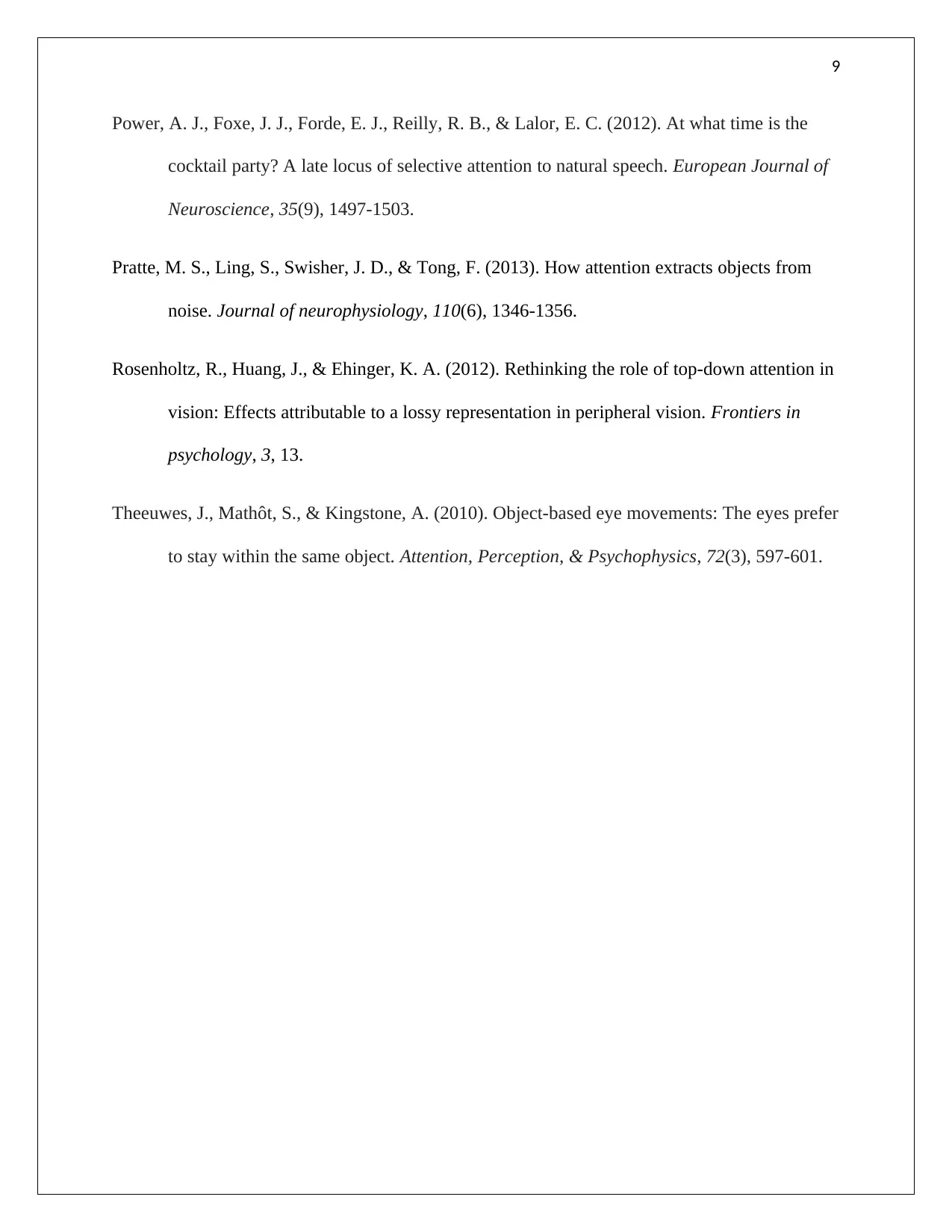
9
Power, A. J., Foxe, J. J., Forde, E. J., Reilly, R. B., & Lalor, E. C. (2012). At what time is the
cocktail party? A late locus of selective attention to natural speech. European Journal of
Neuroscience, 35(9), 1497-1503.
Pratte, M. S., Ling, S., Swisher, J. D., & Tong, F. (2013). How attention extracts objects from
noise. Journal of neurophysiology, 110(6), 1346-1356.
Rosenholtz, R., Huang, J., & Ehinger, K. A. (2012). Rethinking the role of top-down attention in
vision: Effects attributable to a lossy representation in peripheral vision. Frontiers in
psychology, 3, 13.
Theeuwes, J., Mathôt, S., & Kingstone, A. (2010). Object-based eye movements: The eyes prefer
to stay within the same object. Attention, Perception, & Psychophysics, 72(3), 597-601.
Power, A. J., Foxe, J. J., Forde, E. J., Reilly, R. B., & Lalor, E. C. (2012). At what time is the
cocktail party? A late locus of selective attention to natural speech. European Journal of
Neuroscience, 35(9), 1497-1503.
Pratte, M. S., Ling, S., Swisher, J. D., & Tong, F. (2013). How attention extracts objects from
noise. Journal of neurophysiology, 110(6), 1346-1356.
Rosenholtz, R., Huang, J., & Ehinger, K. A. (2012). Rethinking the role of top-down attention in
vision: Effects attributable to a lossy representation in peripheral vision. Frontiers in
psychology, 3, 13.
Theeuwes, J., Mathôt, S., & Kingstone, A. (2010). Object-based eye movements: The eyes prefer
to stay within the same object. Attention, Perception, & Psychophysics, 72(3), 597-601.

10
Appendix
Supplementary Materials from raw SPSS outputs
Table 2: Tests of Normality
Kolmogorov-Smirnova Shapiro-Wilk
Statistic df Sig. Statistic df Sig.
RT_Congruent .077 149 .031 .963 149 .001
RT_Neutral .075 149 .041 .967 149 .001
RT_Incongruent .073 149 .048 .972 149 .004
a. Lilliefors Significance Correction
Figure 1: Q-Q plot for response time in congruent distraction
Appendix
Supplementary Materials from raw SPSS outputs
Table 2: Tests of Normality
Kolmogorov-Smirnova Shapiro-Wilk
Statistic df Sig. Statistic df Sig.
RT_Congruent .077 149 .031 .963 149 .001
RT_Neutral .075 149 .041 .967 149 .001
RT_Incongruent .073 149 .048 .972 149 .004
a. Lilliefors Significance Correction
Figure 1: Q-Q plot for response time in congruent distraction
Secure Best Marks with AI Grader
Need help grading? Try our AI Grader for instant feedback on your assignments.
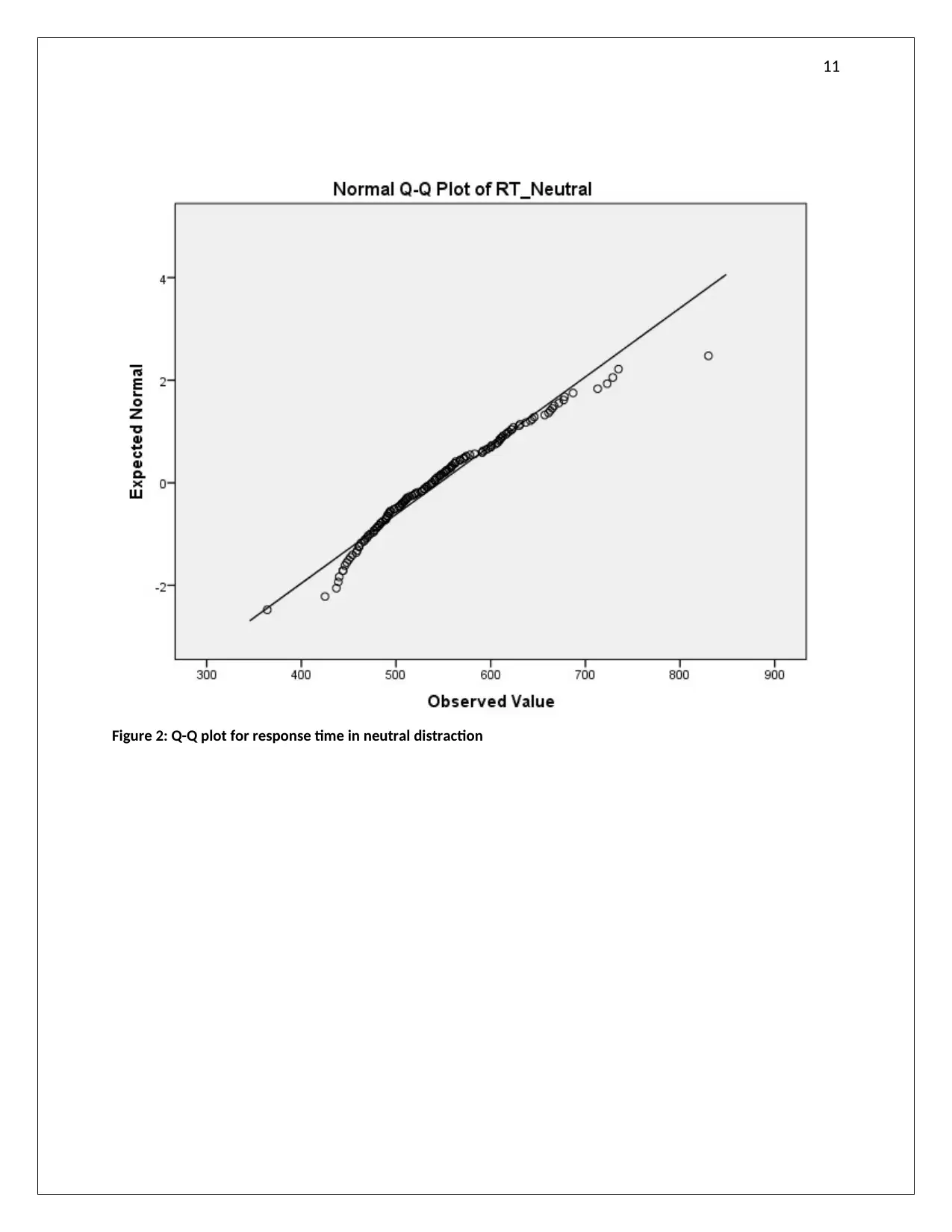
11
Figure 2: Q-Q plot for response time in neutral distraction
Figure 2: Q-Q plot for response time in neutral distraction

12
Figure 3: Q-Q plot for response time in incongruent distraction
Table 3: Descriptives of variables
N Mean Std.
Deviation
Std.
Error
95% Confidence Interval for
Mean
Minimu
m
Maximu
m
Lower Bound Upper Bound
RT_Congruent 14
9
541.0
7 75.477 6.183 528.85 553.29 378 828
RT_Neutral 14
9
546.0
7 74.543 6.107 534.01 558.14 364 830
RT_Incongruen
t
14
9
594.4
8 84.058 6.886 580.87 608.08 386 889
Figure 3: Q-Q plot for response time in incongruent distraction
Table 3: Descriptives of variables
N Mean Std.
Deviation
Std.
Error
95% Confidence Interval for
Mean
Minimu
m
Maximu
m
Lower Bound Upper Bound
RT_Congruent 14
9
541.0
7 75.477 6.183 528.85 553.29 378 828
RT_Neutral 14
9
546.0
7 74.543 6.107 534.01 558.14 364 830
RT_Incongruen
t
14
9
594.4
8 84.058 6.886 580.87 608.08 386 889
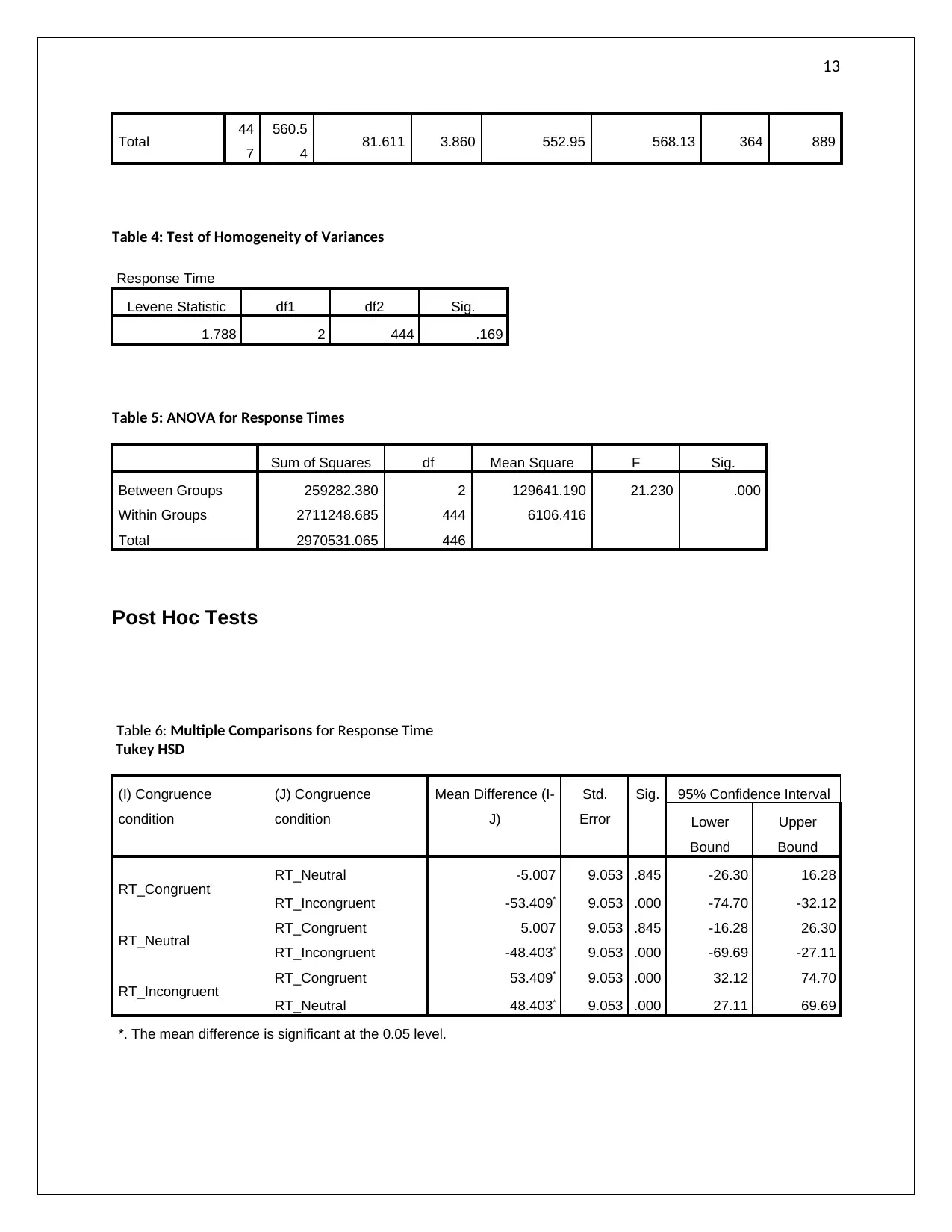
13
Total 44
7
560.5
4 81.611 3.860 552.95 568.13 364 889
Table 4: Test of Homogeneity of Variances
Response Time
Levene Statistic df1 df2 Sig.
1.788 2 444 .169
Table 5: ANOVA for Response Times
Sum of Squares df Mean Square F Sig.
Between Groups 259282.380 2 129641.190 21.230 .000
Within Groups 2711248.685 444 6106.416
Total 2970531.065 446
Post Hoc Tests
Table 6: Multiple Comparisons for Response Time
Tukey HSD
(I) Congruence
condition
(J) Congruence
condition
Mean Difference (I-
J)
Std.
Error
Sig. 95% Confidence Interval
Lower
Bound
Upper
Bound
RT_Congruent RT_Neutral -5.007 9.053 .845 -26.30 16.28
RT_Incongruent -53.409* 9.053 .000 -74.70 -32.12
RT_Neutral RT_Congruent 5.007 9.053 .845 -16.28 26.30
RT_Incongruent -48.403* 9.053 .000 -69.69 -27.11
RT_Incongruent RT_Congruent 53.409* 9.053 .000 32.12 74.70
RT_Neutral 48.403* 9.053 .000 27.11 69.69
*. The mean difference is significant at the 0.05 level.
Total 44
7
560.5
4 81.611 3.860 552.95 568.13 364 889
Table 4: Test of Homogeneity of Variances
Response Time
Levene Statistic df1 df2 Sig.
1.788 2 444 .169
Table 5: ANOVA for Response Times
Sum of Squares df Mean Square F Sig.
Between Groups 259282.380 2 129641.190 21.230 .000
Within Groups 2711248.685 444 6106.416
Total 2970531.065 446
Post Hoc Tests
Table 6: Multiple Comparisons for Response Time
Tukey HSD
(I) Congruence
condition
(J) Congruence
condition
Mean Difference (I-
J)
Std.
Error
Sig. 95% Confidence Interval
Lower
Bound
Upper
Bound
RT_Congruent RT_Neutral -5.007 9.053 .845 -26.30 16.28
RT_Incongruent -53.409* 9.053 .000 -74.70 -32.12
RT_Neutral RT_Congruent 5.007 9.053 .845 -16.28 26.30
RT_Incongruent -48.403* 9.053 .000 -69.69 -27.11
RT_Incongruent RT_Congruent 53.409* 9.053 .000 32.12 74.70
RT_Neutral 48.403* 9.053 .000 27.11 69.69
*. The mean difference is significant at the 0.05 level.
Paraphrase This Document
Need a fresh take? Get an instant paraphrase of this document with our AI Paraphraser
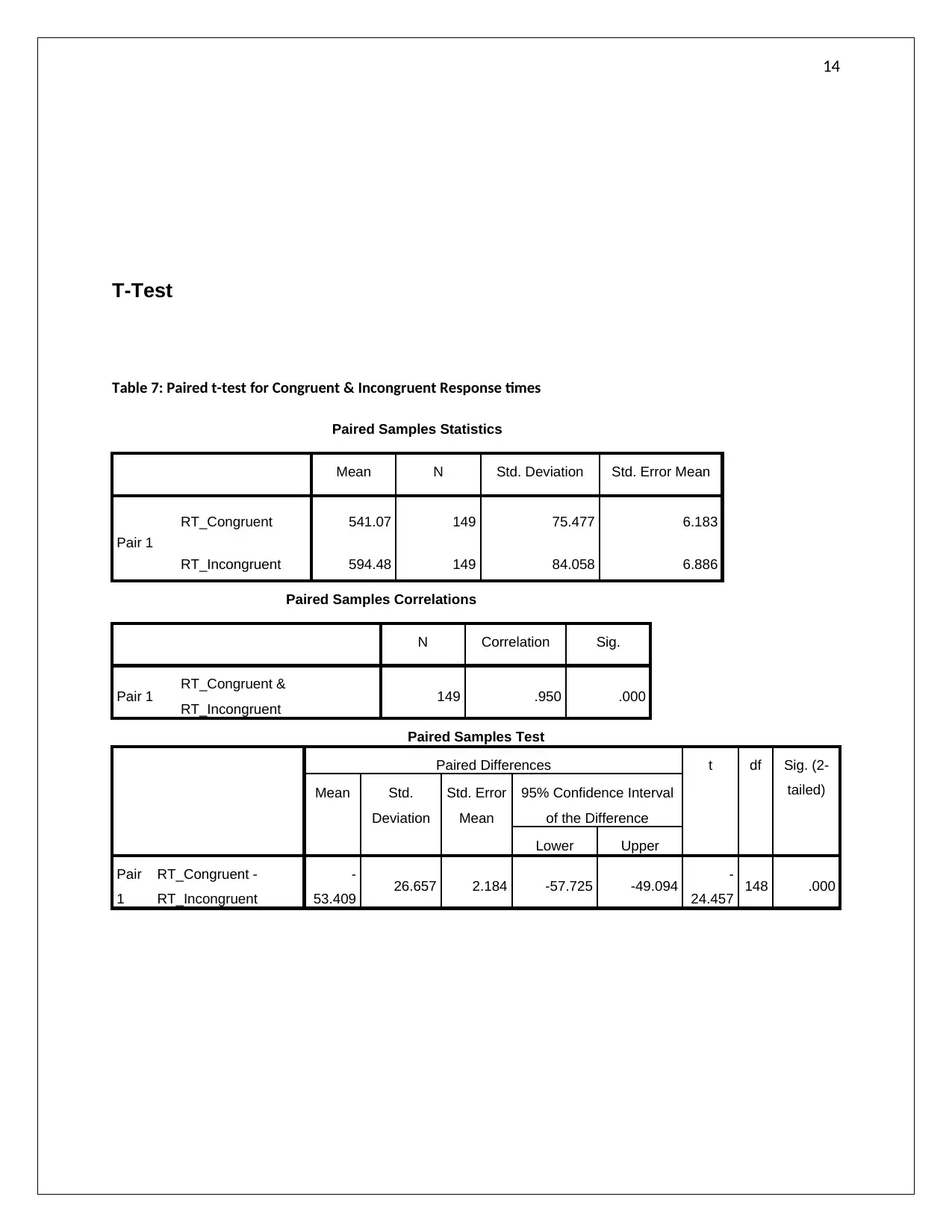
14
T-Test
Table 7: Paired t-test for Congruent & Incongruent Response times
Paired Samples Statistics
Mean N Std. Deviation Std. Error Mean
Pair 1
RT_Congruent 541.07 149 75.477 6.183
RT_Incongruent 594.48 149 84.058 6.886
Paired Samples Correlations
N Correlation Sig.
Pair 1 RT_Congruent &
RT_Incongruent 149 .950 .000
Paired Samples Test
Paired Differences t df Sig. (2-
tailed)Mean Std.
Deviation
Std. Error
Mean
95% Confidence Interval
of the Difference
Lower Upper
Pair
1
RT_Congruent -
RT_Incongruent
-
53.409 26.657 2.184 -57.725 -49.094 -
24.457 148 .000
T-Test
Table 7: Paired t-test for Congruent & Incongruent Response times
Paired Samples Statistics
Mean N Std. Deviation Std. Error Mean
Pair 1
RT_Congruent 541.07 149 75.477 6.183
RT_Incongruent 594.48 149 84.058 6.886
Paired Samples Correlations
N Correlation Sig.
Pair 1 RT_Congruent &
RT_Incongruent 149 .950 .000
Paired Samples Test
Paired Differences t df Sig. (2-
tailed)Mean Std.
Deviation
Std. Error
Mean
95% Confidence Interval
of the Difference
Lower Upper
Pair
1
RT_Congruent -
RT_Incongruent
-
53.409 26.657 2.184 -57.725 -49.094 -
24.457 148 .000

15
T-Test
Table 8: Paired t-test for Neutral & Incongruent Response times
Paired Samples Statistics
Mean N Std. Deviation Std. Error Mean
Pair 1 RT_Neutral 546.07 149 74.543 6.107
RT_Incongruent 594.48 149 84.058 6.886
Paired Samples Correlations
N Correlation Sig.
Pair 1 RT_Neutral & RT_Incongruent 149 .968 .000
Paired Samples Test
Paired Differences t df Sig. (2-
tailed)Mean Std.
Deviation
Std. Error
Mean
95% Confidence Interval
of the Difference
Lower Upper
Pair
1
RT_Neutral -
RT_Incongruent
-
48.403 22.140 1.814 -51.987 -44.818 -
26.686 148 .000
T-Test
Table 8: Paired t-test for Neutral & Incongruent Response times
Paired Samples Statistics
Mean N Std. Deviation Std. Error Mean
Pair 1 RT_Neutral 546.07 149 74.543 6.107
RT_Incongruent 594.48 149 84.058 6.886
Paired Samples Correlations
N Correlation Sig.
Pair 1 RT_Neutral & RT_Incongruent 149 .968 .000
Paired Samples Test
Paired Differences t df Sig. (2-
tailed)Mean Std.
Deviation
Std. Error
Mean
95% Confidence Interval
of the Difference
Lower Upper
Pair
1
RT_Neutral -
RT_Incongruent
-
48.403 22.140 1.814 -51.987 -44.818 -
26.686 148 .000

16
1 out of 16
Your All-in-One AI-Powered Toolkit for Academic Success.
+13062052269
info@desklib.com
Available 24*7 on WhatsApp / Email
![[object Object]](/_next/static/media/star-bottom.7253800d.svg)
Unlock your academic potential
© 2024 | Zucol Services PVT LTD | All rights reserved.
